POSTCARD FROM LIPOWA CAMP
A postcard, written on 13 September 1942, sent one day later.
Sender: " Lisa Schuldberger, Lublin GG, Lindenstr.7, Lager"
Addressee:" Maria Kittel,
Berlin ..."
A young lady sends regards to her little sister. She is sad at not receiving any parcels, although her relatives
have sent some. Since her arrival at the camp three weeks ago, she has had no change of clothing.
Photo: Edward Victor
|
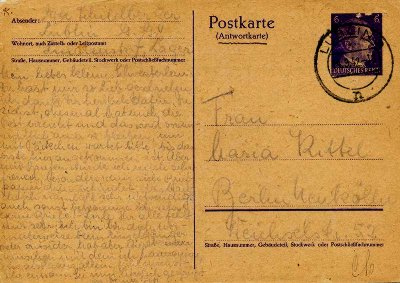 |
The forced labour camp at 7 Lipowa Street (named
Lindenstraße during the occupation) was set up by the
SS- und Polizeiführer
Odilo Globocnik in
October 1939. About 200
Jews from
Lublin were forced to convert the former sports field of the
"Lublin Academic Sports Organisation" into a POW camp. Barracks were built for manual workers.
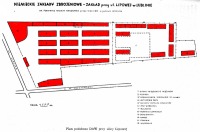 |
| Camp Map |
Jewish POWs of the Polish Army were imprisoned here. They were captured in
September 1939 during the German
invasion of Poland. Some 1,000 Jews, both POWs and civilians,
were crowded together in the camp. In total, about 7,000 Jewish POWs passed through the camp.
From
spring 1940, until end of that year, around 3,200 POWs who came from
German-occupied Poland were released.
The Jews who had their homes in the parts of Poland annexed by the Soviet Union
remained in the camp. They received assistance from the Jewish community in
Lublin
whose members collected money, clothes, medicine etc and searched for families who
were willing to house the internees. Thus most of these POWs were released in
June 1940.
From 14 August until 7 September 1940 the Lipowa Street Camp became a transit camp
for Jewish forced labourers: more than 15,000 Jews arrived and after a short time
were sent to other camps in the
Lublin district. In
February 1941, around
3,000 Jews no longer classified as POWs remained in the camp. They had to labour in workshops and several hundreds
of them were forced to build the concentration camp at
KZ Majdanek, near to the city.
In
December 1940, the SS company
DAW (
Deutsche Ausrüstungswerke)
had taken possession
of the camp. The
DAW Lindenstraße (Lipowa Street) was a firm employing exclusively Jewish slave labour and
producing mainly wooden articles, which were made with the most modern machinery. There were also
tailoring and cobbler's shops, saddlers, tanneries and printing works utilising this slave labour.
Jews from Lipowa Camp were sent to other SS factories for work, whilst those captured in periodic
roundups in the
Lublin Ghetto were brought to the camp. The Lipowa Camp also
played a role in sorting the belongings of the victims of
Aktion Reinhard, specializing in shoes.
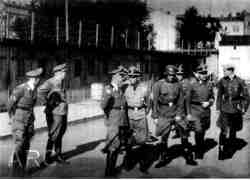 |
| Himmler at Lipowa Camp on 20 July 1941 |
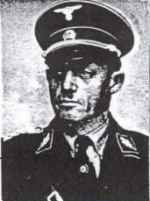 |
| Hermann Dolp |
The SS guards
("
Trawnikis") came from
Majdanek.
The Lipowa Camp commander was
SS-Sturmbannführer Hermann Dolp.
The conditions in the camp were exceptionally brutal. Minor infringements of the camp regulations often
resulted in a prisoner's death. For a single escapee, ten other prisoners were hanged. From
time to time large groups were selected for death and sent to
Majdanek. For
example, on
17 August 1942 several hundred inmates were chosen for transfer
to
Majdanek, but the shoemakers amongst them used their knives to attack the
guards, wounding and even killing some of the latter. Nonetheless, those prisoners not being immediately shot by
the SS, were taken to
Majdanek.
During the existence of the camp a resistance organisation was active, led by
Roman Fiszer. Little by little about 400
Jews were able to escape during the
winter of 1942/43. Most of them were caught and shot,
but about 150 reached the forests and joined two underground groups which later
became part of the "Gwardia Ludowa" partisans.
After the
Sobibor Uprising (
14 October 1943)
Himmler issued an order to kill all of the remaining Jews in the
Lublin district labour camps. This mass murder took place simultaneously
in the forced labour camps on
3 and 4 November 1943. The code name was
Aktion Erntefest ("Action Harvest Festival"), organized
by the
SS- und Polizeiführer Jacob Sporrenberg,
the successor to
Globocnik.
 |
| Lipowa Camp 1942* |
On
3 November, the last 2,500 Jews from the Lipowa Camp set out on their final march
to
Majdanek. The prisoners attempted to escape en route, but their efforts
were in vain.
Later, the Lipowa Camp became an outer camp of
Majdanek. Small groups of
prisoners worked there. In
February 1944, 500 non-Jews from German concentration camps
were taken to the Lipowa Camp.
On
22 July 1944 the camp was liquidated. The remaining 229 inmates were sent to
Auschwitz.
Actually (December 2005) construction works have started to build a large entertainment complex at the site,
the Plaza Centers Lublin (possibly including restaurants, cinemas, shops, etc.). This project might destroy the
remnants (concrete foundations and a small part of a
barrack wall) of the former camp where so many people were murdered.
The photograph of
Himmler at the Lipowa Camp
is provided by courtesy of
Peter Witte, co-author of
the book "Der Dienstkalender Heinrich Himmlers 1941/42".
The enlargement of the photograph has been enhanced by ARC.
Photos: Marek Gromaszek
*
Sources:
Pinkas Hakehillot.
"Lublin" - Encyclopedia Of Jewish Communities in Poland, Vol.7. Yad Vashem.
Israel Gutman.
Encyclopedia of the Holocaust.
Robert Kuwalek, Lublin
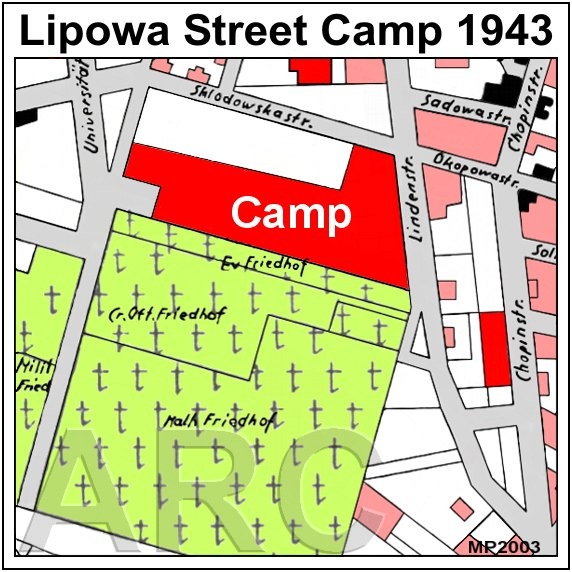 |
| Camp Location - see Lublin City Map |
© ARC 2005















